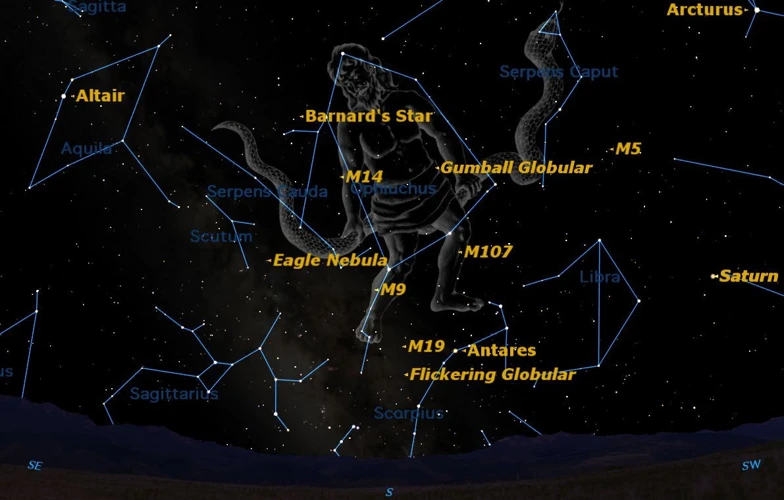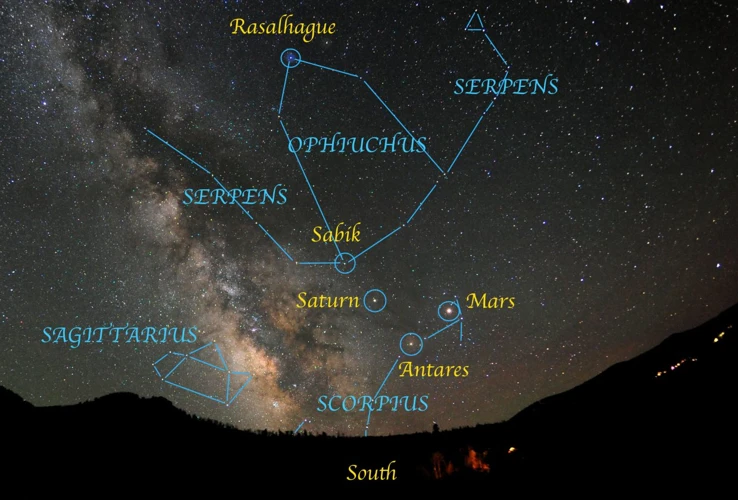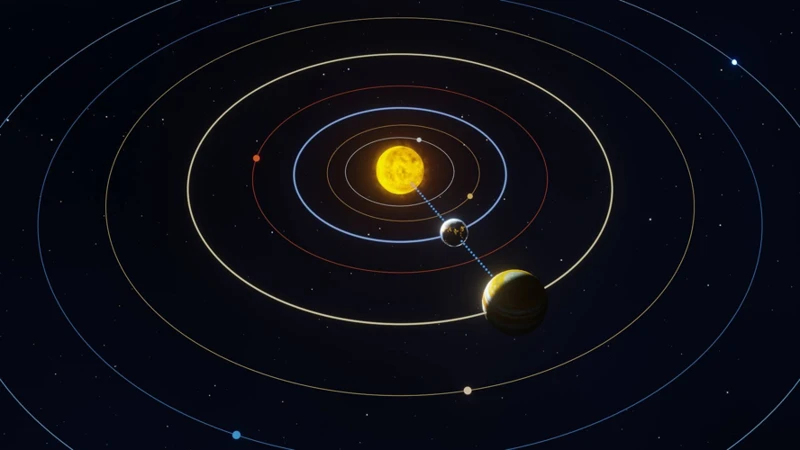Have you ever wondered about the mysteries and significance of planetary alignments throughout history? These celestial events have captivated human curiosity since ancient times, inspiring astronomical practices, cultural interpretations, and even architectural designs. In this article, we will delve into the historical importance of planetary alignments, exploring ancient observations, noteworthy alignments throughout history, the influence of alignments in different aspects of life, theories and speculations surrounding them, and what the future holds for our understanding of these cosmic phenomena. Join us on this journey as we uncover the secrets behind these captivating celestial occurrences.
Contents
- Ancient Observations
- Noteworthy Alignments Throughout History
- The Influence of Planetary Alignments
- Theories and Speculations
- The Future of Planetary Alignments
- Conclusion
-
Frequently Asked Questions
- 1. How did ancient civilizations make observations of planetary alignments?
- 2. What cultural significance did planetary alignments hold for ancient civilizations?
- 3. Did ancient civilizations interpret planetary alignments differently?
- 4. What are some examples of noteworthy planetary alignments in history?
- 5. Are there any geological or environmental impacts associated with planetary alignments?
- 6. What role do planetary alignments play in astrology?
- 7. How accurate were ancient civilizations’ observations of planetary alignments?
- 8. Is there a connection between planetary alignments and mythology?
- 9. What role do planetary alignments play in modern science?
- 10. What technological advancements have helped us better observe and understand planetary alignments?
- References
-
Frequently Asked Questions
- 1. How did ancient civilizations observe planetary alignments?
- 2. What cultural interpretations were associated with planetary alignments?
- 3. How did planetary alignments impact architectural design?
- 4. What is the significance of solstice alignments at Stonehenge?
- 5. How did the Mayan calendar incorporate celestial alignments?
- 6. What stellar alignments can be observed in relation to the Egyptian pyramids?
- 7. What is the astrological perspective on planetary alignments?
- 8. What geological and environmental impacts can result from planetary alignments?
- 9. How do planetary alignments affect societies and cultures?
- 10. What role do technological advancements play in observing planetary alignments?
- References
- Read More
Ancient Observations

Ancient civilizations were keen observers of the night sky, and their observations of planetary alignments have left a lasting impact on history. Early astronomical practices involved meticulous tracking of celestial bodies, leading to the identification of recurring patterns in planetary alignments. These observations were not merely scientific but held immense cultural significance as well. Different cultures interpreted these alignments in unique ways, attributing them to divine messages, omens, or even connection with the spirit realm. Such interpretations shaped the belief systems and rituals of these societies. Additionally, the architectural implications of planetary alignments can be seen in structures like Stonehenge, where solstice alignments were carefully incorporated. These ancient observations continue to intrigue researchers and inspire a sense of wonder about the universe we inhabit.
1. Early Astronomical Practices
Early astronomical practices were rooted in the meticulous observation and tracking of celestial bodies. Ancient civilizations, such as the Egyptians, Babylonians, and Mayans, developed sophisticated techniques to monitor the movements of the planets, stars, and other celestial objects. They built observatories and utilized instruments like sundials and astrolabes to measure and record these observations. Through their keen observations, they noticed recurring patterns and alignments of the planets. These early astronomers played a crucial role in understanding the celestial mechanics and establishing the foundation for future astronomical studies.
One of the notable early astronomical practices was the development of calendars to track the motions of the celestial bodies. For example, the Mayan civilization created a highly accurate calendar called the Long Count, which was based on astronomical alignments and cycles. This calendar system allowed them to predict celestial events and align their agricultural, religious, and social activities accordingly.
In addition to calendar systems, ancient astronomers made significant contributions to the study of constellations. They observed the positions of stars in the night sky and connected them to form meaningful patterns, often representing mythological figures or animals. These constellations served as guides for navigation, timekeeping, and cultural storytelling. They were a fundamental part of early astronomical practices, helping ancient civilizations understand and navigate the vast cosmic expanse above.
The early astronomical practices of ancient civilizations laid the groundwork for our understanding of the universe. The meticulous observations, calendar systems, and study of constellations were vital in unraveling the secrets of celestial movements. These practices not only advanced scientific knowledge but also influenced societal and cultural aspects, shaping rituals, beliefs, and even architectural designs. The significance of early astronomical practices can still be seen today in our continued fascination with the stars and the night sky.
Internal link: Astronomical Alignments and Ancient Constellations
2. Cultural Interpretations of Alignments
Cultural interpretations of planetary alignments offer a fascinating insight into how ancient civilizations viewed these celestial events. Different cultures across the globe developed unique beliefs and mythologies around planetary alignments, infusing them with spiritual and symbolic meanings. For example, the ancient Egyptians associated planetary alignments, particularly with certain stars, with their gods and goddesses. These alignments were believed to hold great significance in terms of divine communication and the ruling powers of their deities. In Native American mythology, planetary alignments were often linked to dreams and visions, where these celestial events were seen as messages from the spirit world. Many indigenous tribes considered such alignments as important guideposts in their spiritual journeys and decision-making processes. The interpretations of alignments varied widely based on cultural beliefs and societal values, highlighting the profound influence that celestial events had on shaping ancient cultures and their understanding of the cosmos. The complexities and rich symbolism associated with cultural interpretations of planetary alignments continue to intrigue researchers and anthropologists today. To learn more about the importance of dream interpretation in Native American mythology, check out this link.
3. Architectural Implications
Architectural Implications:
– Ancient civilizations recognized the significance of planetary alignments and strategically incorporated them into their architectural designs. Structures such as Stonehenge in England, the Chichen Itza in Mexico, and the Great Pyramids of Egypt showcase the incredible precision and ingenuity of ancient architects who aligned their constructions with celestial events.
– Stonehenge, a prehistoric monument composed of large standing stones, is a prime example of architectural dedication to planetary alignments. Its circular layout aligns with the movement of the sun during solstices, suggesting that it was used as a celestial calendar or as a sacred site for solstice ceremonies. This alignment not only demonstrates the meticulous astronomical knowledge of its builders but also showcases their reverence for the cycles of nature.
– The Chichen Itza, an ancient Mayan city, features the famous El Castillo pyramid, which holds architectural significance related to celestial alignments. During the equinoxes, the sun casts a shadow on the pyramid’s northern staircase, creating the illusion of a serpent slithering down the structure – a phenomenon associated with Mayan mythology. This alignment highlights the close relationship between the Mayan calendar, celestial events, and spiritual beliefs.
– In Egypt, the Great Pyramids of Giza are aligned with astonishing precision to the four cardinal directions, with the latter two pyramids of Khafre and Menkaure aligned with the three stars of Orion’s Belt. This alignment has led to speculation about possible connections with ancient Egyptian beliefs in the afterlife and their association with the constellation Orion.
– The incorporation of planetary alignments into architectural designs not only demonstrated the advanced astronomical knowledge of ancient civilizations but also served as a means to connect with the cosmos and the divine. These architectural marvels continue to amaze and intrigue us, serving as lasting testaments to the historical significance of planetary alignments.
(make mention of “recent discoveries breakthroughs meteor shower research” link when discussing ancient astronomical knowledge)
Noteworthy Alignments Throughout History

Throughout history, there have been numerous noteworthy planetary alignments that have captured the imagination of humanity. One example is the fascinating alignment associated with Stonehenge and the solstice. This ancient monument, constructed thousands of years ago, aligns with the rising and setting sun during the summer and winter solstices, creating a spectacle of light and shadow. Another remarkable alignment can be found in the Mayan calendar, which was intricately connected to celestial events. The Mayans closely observed the movements of the planets, and their calendar accurately predicted various celestial alignments and phenomena. The Egyptian pyramids also exhibit alignment with certain stars, such as the alignment of the three pyramids at Giza with the belt of the Orion constellation. These extraordinary celestial alignments highlight the deep connection between ancient civilizations and the cosmos, inspiring further research and unearthing new discoveries in the field of astronomy.
1. Stonehenge and Solstice Alignments
One of the most famous examples of the historical significance of planetary alignments is found in the ancient monument of Stonehenge. This enigmatic structure, located in England, is believed to have been built over 5,000 years ago. While the purpose of Stonehenge remains shrouded in mystery, one of its fascinating aspects is its alignment with the solstices. During the summer solstice, the rising sun aligns perfectly with the Heel Stone, casting a beam of light through the center of the monument’s stones. Similarly, during the winter solstice, the setting sun aligns with the stones, creating a mesmerizing spectacle. This precise alignment suggests that Stonehenge was used as an astronomical calendar, marking important celestial events such as solstices and possibly even other planetary alignments. The significance of these alignments to the ancient people who built Stonehenge remains a subject of speculation and wonder. To this day, the solstice alignments at Stonehenge draw crowds of visitors who gather to witness this ancient celestial phenomenon and ponder the mysteries of our ancestors’ connection to the celestial realm.
2. Mayan Calendar and Celestial Alignments
The Mayan civilization, known for their advanced understanding of astronomy, developed a highly accurate calendar system that incorporated celestial alignments. The Mayan calendar was not just a way to keep track of time but also a reflection of their spiritual beliefs and agricultural practices. One prominent example of celestial alignments in the Mayan calendar is the Long Count, which is based on the alignment of celestial bodies such as the sun, moon, and Venus. This calendar cycle, spanning over 5,000 years, played a crucial role in their religious ceremonies and prophecies. The Mayans believed that certain alignments held significant meaning and could influence human affairs and natural events.
One fascinating aspect of Mayan celestial alignments is their connection to the movement of Venus. The Mayans observed that the cycles of Venus aligned with important events in their society, such as the coronations of rulers and the construction of significant temples. These observations allowed the Mayans to accurately predict Venusian movements and incorporate them into their calendar system. The understanding of these celestial alignments highlights the Mayans’ advanced astronomical knowledge and their ability to incorporate it into their daily lives.
The Mayans also used alignments with other celestial bodies, such as the sun and moon, to determine auspicious dates for agricultural activities, religious ceremonies, and even warfare. These alignments were believed to have direct impacts on the success and outcomes of various aspects of Mayan life. The Mayans’ ability to accurately predict and interpret celestial alignments demonstrates their sophisticated understanding of the cosmos and how they perceived the interconnectedness of celestial events with earthly affairs.
The study of Mayan calendar and celestial alignments continues to unveil new insights and discoveries. Recent research and archaeological findings have shed light on the intricate relationship between the Mayan calendar, celestial alignments, and significant events in Mayan history. Scientists have uncovered fascinating connections between Mayan cosmology, astronomy, and their understanding of the universe.
The Mayan calendar and celestial alignments were not only tools for measuring time but also held immense cultural and spiritual significance for the Mayan civilization. Their intricate understanding of celestial events and their incorporation into their calendar system showcases the Mayans’ advanced astronomical knowledge and their belief in the influence of the cosmos on human affairs. This remarkable connection between Mayan culture and celestial alignments continues to captivate researchers and inspire further exploration into the mysteries of this ancient civilization.
(Suggested anchor text: recent discoveries and breakthroughs in meteor shower research)
3. Egyptian Pyramids and Stellar Alignments
The Egyptian pyramids have long fascinated historians and archaeologists, and their alignment with the stars adds another layer of intrigue to these ancient structures. The ancient Egyptians possessed an advanced understanding of astronomy and incorporated stellar alignments into the design and construction of their pyramids. One notable example is the Great Pyramid of Giza, which aligns perfectly with the constellation Orion. The three main pyramids of Giza are positioned in such a way that their diagonals form a nearly perfect straight line. This alignment is believed to mirror the position of the three stars in Orion’s Belt. The precision and intentional alignment of the pyramids to specific constellations highlight the importance of astronomy in ancient Egyptian culture. While the exact purpose of these alignments is still a subject of debate among researchers, it is clear that the Egyptians held a deep reverence for the stars and sought to connect their monumental structures with the celestial realm. Exploring the connection between the Egyptian pyramids and stellar alignments continues to shed light on the knowledge and beliefs of this remarkable civilization.
Recent discoveries have provided further insights into the alignment of the pyramids and their astronomical significance. These breakthroughs in meteor shower research and other related fields have allowed scientists to better understand the ancient Egyptians’ astronomical observations and the role they played in shaping the design and orientation of the pyramids. The study of stellar alignments in relation to the Egyptian pyramids remains an ongoing area of research, with new discoveries and interpretations adding to our understanding of the historical significance behind these remarkable structures.
The Influence of Planetary Alignments

The influence of planetary alignments extends beyond the realm of astronomy. Astrological perspectives have long linked these alignments to personal traits, future events, and even compatibility between individuals. While scientific evidence may not support astrological claims, the cultural impact of these beliefs cannot be denied. Planetary alignments have geological and environmental impacts. For instance, the gravitational effects of alignments can create tidal forces, influencing ocean currents and potentially affecting weather patterns. In terms of societal and cultural effects, planetary alignments have inspired art, literature, and religious practices throughout history. Whether through the creation of zodiac signs or the integration of celestial symbolism in ancient mythology, these alignments have left an indelible mark on human culture. So while the scientific implications of planetary alignments may be debated, their influence on various facets of life continues to fascinate and captivate us.
1. Astrological Perspectives
Astrological perspectives on planetary alignments have been an integral part of human beliefs and practices for centuries. Astrology, the study of the correlation between celestial events and human affairs, places great importance on planetary alignments and their potential influence on individuals and societies. According to astrologers, the alignments of the planets at the time of a person’s birth can determine their personality traits, compatibility with others, and even future events in their lives. Each planet is believed to possess distinct energies and meanings that can shape an individual’s character and destiny. For example, the alignment of Mercury is associated with communication and intellect, while Mars is linked to assertiveness and passion. Astrologers use complex charts and calculations to interpret the impact of planetary alignments on human lives. While astrology is often seen as a pseudoscience, it continues to fascinate and provide guidance to many individuals seeking meaning and insight into their lives. Whether viewed as a source of comfort or skepticism, astrological perspectives on planetary alignments have undeniably had a significant cultural and personal impact throughout history.
2. Geological and Environmental Impacts
Geological and environmental impacts of planetary alignments have been a subject of fascination and inquiry. While the exact nature of these impacts is still under investigation, there are several theories and hypotheses regarding their potential influence.
One aspect of geological impact relates to tides and gravitational forces exerted by the alignment of celestial bodies. The gravitational pull of the moon, in particular, is known to cause tides on Earth. When combined with the gravitational effects from other planets aligning, there could be additional variations in tidal patterns, leading to changes in coastal ecosystems and the distribution of marine life.
Some researchers speculate that planetary alignments may have subtle influences on seismic activities, including earthquakes and volcanic eruptions. Although the evidence linking alignments to geological events is inconclusive, there have been instances where increased earthquake activity coincided with specific alignments. However, it is important to note that the Earth’s internal processes play a significant role in these occurrences, and the influence of planetary alignments, if any, is likely to be minor.
On the environmental front, planetary alignments have the potential to impact weather patterns and climatic conditions. The gravitational forces exerted by aligned celestial bodies might influence atmospheric circulation patterns, leading to variations in weather systems, such as the formation of storms or shifts in wind patterns. However, these influences are likely to be temporary and short-lived, as the Earth’s atmosphere is subject to a complex interplay of multiple factors.
It is essential to approach the topic of geological and environmental impacts of planetary alignments with scientific rigor and skepticism. While the concept is intriguing, more research and empirical evidence are needed to draw definitive conclusions about their significance. The quest to understand the connection between celestial alignments and geological or environmental changes remains an active area of study, making it an exciting field to watch for future breakthroughs and discoveries.
3. Societal and Cultural Effects
Societal and cultural effects of planetary alignments have been significant throughout history. Many ancient societies believed that planetary alignments had a direct influence on human affairs and could impact various aspects of life. Astrology, for example, is an intricate system that associates planetary alignments with personality traits, relationships, and even future events. The alignment of celestial bodies was thought to affect individuals’ destinies and provide guidance on important decisions. From ancient civilizations to modern times, astrology continues to shape beliefs, influencing everything from personal relationships to career choices.
Planetary alignments have also played a crucial role in cultural practices and traditions. Festivals and celebrations often revolve around notable alignments, with specific rituals and ceremonies being conducted during these celestial events. For example, in Hindu culture, the festival of Diwali is celebrated during the new moon, symbolizing the triumph of light over darkness. Similarly, the Chinese New Year is determined by the lunar calendar, which considers the alignment of the sun, moon, and various planets.
These alignments have also had an impact on art, literature, and mythology. They have been depicted in ancient cave paintings, mythology, and folklore of different cultures. The alignment of celestial bodies often represented divine interactions, giving birth to mythical stories and legends. These cultural effects highlight the deep connection between humans and the cosmos, as well as the profound influence that planetary alignments have had on shaping human culture and society.
Planetary alignments have left a lasting impact on society and culture throughout history. From astrology to cultural practices and creative expressions, these alignments have influenced and shaped belief systems, rituals, and artistic representations. The fascination and awe inspired by planetary alignments continue to captivate our imaginations and remind us of the intricate relationship between the celestial and the human.
Theories and Speculations

The study of planetary alignments throughout history has given rise to various theories and speculations that continue to ignite curiosity and debate among scientists and enthusiasts alike. One prominent area of discussion revolves around the astronomical accuracy of historical observations. Researchers question the degree of precision in ancient civilizations’ understanding of planetary movements and alignments. Another intriguing aspect is the connection between these alignments and mythology. Many cultures have linked celestial events to their mythological narratives, leading to speculation about a possible cosmic influence on ancient stories and belief systems. Additionally, some theorists explore extraterrestrial hypotheses, suggesting that advanced beings or civilizations may have had a hand in orchestrating planetary alignments for mysterious purposes. These theories offer alternative perspectives and contribute to the ongoing fascination with planetary alignments and their significance in our understanding of the universe.
1. Astronomical Accuracy of Historical Observations
When considering the astronomical accuracy of historical observations, it is essential to appreciate the limitations and challenges faced by ancient astronomers. Despite not having the sophisticated instruments and technology available today, these early astronomers made impressive and remarkably precise observations. They carefully tracked planetary movements, recorded positions, and noted alignments with other celestial bodies. However, it is important to acknowledge that their measurements were subject to various factors that could affect accuracy, such as atmospheric conditions, human error, and lack of standardized measurement units. It is also crucial to take into account the limitations of their knowledge and understanding of celestial mechanics. Nevertheless, recent studies and comparisons with modern astronomical data have demonstrated the surprising accuracy achieved by these ancient observers. Their ability to predict eclipses, identify planetary retrogrades, and track the movements of stars and planets over long periods of time is a testament to their keen observational skills and dedication to the study of the night sky. While there may have been some discrepancies and errors among historical observations, their overall astronomical accuracy is impressive considering the tools and knowledge available to them.
2. The Connection between Alignments and Mythology
The connection between planetary alignments and mythology is a fascinating aspect of human history. Mythology, with its rich tapestry of stories and legends, often weaves celestial events and alignments into its narratives. Across different cultures and civilizations, these alignments were believed to hold profound symbolic meanings, representing the interactions between gods, heroes, and celestial beings. In Greek mythology, for example, the alignment of planets and stars was often interpreted as a reflection of divine interactions and interventions in human affairs. The famous mythological tale of Orion and the Pleiades, where the constellation Orion is depicted chasing the Pleiades across the sky, can be seen as an adaptation of the actual astronomical phenomenon of their alignment. Similarly, Native American mythology often incorporates celestial alignments into their creation stories and spiritual beliefs. The alignment of stars and planets was seen as a direct line of communication between the earthly realm and the spirit world. These mythological interpretations not only connected ancient cultures to the cosmos but also provided a sense of meaning and purpose to their existence. The profound influence of planetary alignments on mythology highlights the deep-rooted human fascination with the celestial realm and our continuous endeavor to understand and interpret its mysteries.
3. Extraterrestrial Hypotheses
Extraterrestrial hypotheses have long been a subject of speculation when discussing the historical significance of planetary alignments. Some theorists propose that these alignments could be more than just astronomical phenomena, but rather intentional messages or communications from advanced extraterrestrial civilizations. The idea suggests that these civilizations may have had the knowledge and capability to align celestial bodies for specific purposes, such as marking important dates or sending signals across space. This hypothesis is fueled by the belief that ancient civilizations could not have possessed the astronomical knowledge required to accurately predict and observe these planetary alignments without outside assistance. They argue that advanced extraterrestrial beings may have imparted their wisdom to humans, guiding them in their observations and interpretations. While the extraterrestrial hypothesis remains speculative and controversial, it continues to capture the imagination of many and adds a sense of mystery to the already intriguing topic of planetary alignments.
The Future of Planetary Alignments

The future of planetary alignments holds exciting prospects with advancements in technology and the potential for new discoveries. Technological advancements in observation, such as more powerful telescopes and sophisticated imaging techniques, will allow scientists to gather more detailed data on planetary alignments. This, in turn, can lead to a deeper understanding of the mechanisms behind these alignments and their effects on celestial bodies. With ongoing research and exploration, there are still discoveries yet to be made in the field of planetary alignments. Who knows what fascinating insights await us in the coming years? The relevance of planetary alignments in modern science continues to expand. From studying the geological and environmental impacts of these alignments to exploring their influence on societal and cultural practices, their importance reaches far beyond ancient civilizations. As our understanding grows, so too will our appreciation for the historical significance and potential future implications of planetary alignments.
1. Technological Advancements in Observation
Technological advancements have revolutionized the field of observation, allowing astronomers to study planetary alignments with unprecedented precision. Modern telescopes equipped with advanced imaging technologies, such as high-resolution cameras and spectrographs, provide detailed data on celestial bodies and their movements. These tools enable astronomers to accurately measure and analyze the alignment of planets, stars, and other celestial objects. Additionally, computer modeling and simulation software have become indispensable in understanding and predicting planetary alignments. These digital tools allow scientists to simulate various astronomical scenarios and study the effects of planetary alignments on a virtual scale. Space missions and satellites have played a crucial role in expanding our understanding of planetary alignments. Missions like NASA’s Kepler Space Telescope have discovered exoplanets and provided valuable insights into the prevalence of planetary systems and their alignments. As technology continues to advance, we can expect even more sophisticated instruments and techniques to enhance our understanding of planetary alignments in the future. The evolving technological landscape promises exciting new discoveries and a deeper exploration of the mysteries of planetary alignments.
2. Discoveries Yet to Be Made
The exploration of planetary alignments is an ongoing endeavor, and there are still many discoveries awaiting us in the future. Scientists and astronomers around the world are continuously pushing the boundaries of knowledge and technology to uncover new insights into these celestial phenomena. Here are some areas where future discoveries may be made:
1. Astronomical advancements: With the advancement of technology, such as high-resolution telescopes and space exploration missions, we can expect more detailed observations and measurements of planetary alignments. This could lead to a deeper understanding of the interactions between celestial bodies and how they affect our planetary system.
2. Uncharted celestial events: While we have made significant progress in identifying and studying planetary alignments, there may still be undiscovered or lesser-known celestial events waiting to be found. By exploring different regions of the cosmos and studying the movements of celestial bodies, scientists can uncover new alignments and patterns that were previously unknown.
3. Interdisciplinary research: Future discoveries in planetary alignments may also arise through interdisciplinary collaborations. By combining the knowledge and expertise of astronomers, geologists, anthropologists, and other fields, we can gain a more holistic understanding of the significance and impact of these alignments on various aspects of our world.
4. Technological innovations: The development of new technologies, such as advanced imaging techniques and data analysis algorithms, can provide us with improved methods of studying and interpreting planetary alignments. These innovations may allow us to uncover subtle relationships and connections that were previously unnoticed.
As we continue to explore the mysteries of planetary alignments, there is no doubt that there are still numerous discoveries yet to be made. Each new finding opens up new questions and paves the way for further exploration, deepening our understanding of the cosmos and our place within it.
3. Relevance in Modern Science
The study of planetary alignments remains highly relevant in modern science, as it provides valuable insights into various fields of research.
1. Astronomy and Astrophysics: Planetary alignments offer opportunities for astronomers and astrophysicists to study the dynamics and gravitational interactions between celestial bodies. By observing and analyzing these alignments, scientists can gain a better understanding of the mechanics of our solar system and beyond. This knowledge contributes to advancements in space exploration, planetary science, and the search for exoplanets.
2. Space Weather: Planetary alignments have relevance in studying space weather phenomena such as solar flares, coronal mass ejections, and geomagnetic storms. These events can impact Earth’s magnetic field, satellites, communication systems, and even power grids. The alignment of multiple planets can enhance the effects of space weather events, and studying these alignments helps scientists develop models and forecasts to mitigate potential risks.
3. Geophysics and Geology: Planetary alignments can have subtle influences on Earth’s tides and seismic activities. Understanding the correlations between alignments and geological phenomena can provide insights into the Earth’s interior dynamics, including plate tectonics and volcanic activity. This knowledge is crucial for hazard assessment and disaster preparedness.
4. Space Missions: Knowledge of planetary alignments is essential for planning space missions, especially for interplanetary travel. By taking advantage of the alignment of planets, spacecraft can optimize their trajectories and minimize travel time and fuel consumption. These alignments can also enable gravity-assist maneuvers, allowing spacecraft to gain speed or change their course with minimal propellant use.
5. Scientific Inquiry and Discovery: Exploring the historical significance and scientific implications of planetary alignments fuels scientific curiosity and drives further research. As technology advances, new discoveries and unexplored connections may emerge, shedding light on the countless mysteries of our universe.
The relevance of planetary alignments in modern science extends to various disciplines, from astronomy and astrophysics to geophysics and space missions. The study of these alignments continues to unlock new knowledge and deepen our understanding of the cosmos, paving the way for exciting breakthroughs and discoveries in the future.
Conclusion

In conclusion, the exploration of the historical significance of planetary alignments reveals a fascinating interaction between celestial phenomena and human civilization. Ancient observations of planetary alignments not only advanced astronomical knowledge but also shaped cultural interpretations and influenced architectural designs. From Stonehenge’s solstice alignments to the Mayan calendar’s celestial alignments and the stellar alignments of the Egyptian pyramids, these historical examples showcase the enduring impact of planetary alignments on human history. The influence of planetary alignments extends beyond the physical realm, with astrological perspectives, geological and environmental impacts, as well as societal and cultural effects being associated with these celestial occurrences. Theories and speculations surrounding the accuracy of historical observations, the connections between alignments and mythology, and even extraterrestrial hypotheses continue to spark intrigue and debate. While technological advancements in observation and the potential for future discoveries offer exciting prospects, the relevance of planetary alignments in modern science remains significant. As we continue to unravel the mysteries of the cosmos, the study of planetary alignments will undoubtedly provide valuable insights into our past, present, and perhaps even our future.
Frequently Asked Questions

1. How did ancient civilizations make observations of planetary alignments?
Ancient civilizations made observations of planetary alignments through meticulous tracking of celestial bodies using early astronomical practices. They relied on visual observations and recorded the positions of planets, stars, and other celestial objects over time.
2. What cultural significance did planetary alignments hold for ancient civilizations?
Planetary alignments held immense cultural significance for ancient civilizations. They were often believed to be divine messages or omens, and different cultures interpreted them in unique ways according to their belief systems. Planetary alignments played a role in religious rituals, astrological predictions, and even influenced architectural designs.
3. Did ancient civilizations interpret planetary alignments differently?
Yes, ancient civilizations interpreted planetary alignments differently based on their cultural beliefs and mythologies. For example, the Mayans saw celestial alignments as significant in their calendar system, while the Egyptians associated them with their gods and the construction of the pyramids.
4. What are some examples of noteworthy planetary alignments in history?
Stonehenge and its solstice alignments, the Mayan calendar’s celestial alignments, and the stellar alignments found in the design of Egyptian pyramids are all examples of noteworthy planetary alignments throughout history.
5. Are there any geological or environmental impacts associated with planetary alignments?
There have been some speculations about potential geological or environmental impacts associated with planetary alignments, but more research is needed to fully understand their potential effects.
6. What role do planetary alignments play in astrology?
Many astrologers believe that planetary alignments have an influence on individuals’ personalities, relationships, and life events. Astrology enthusiasts use specific planetary alignments to make predictions and interpretations.
7. How accurate were ancient civilizations’ observations of planetary alignments?
Given the limited technological resources available to ancient civilizations, their observations of planetary alignments were remarkably accurate. Their knowledge of celestial movements paved the way for modern understanding and advancements in astronomy.
8. Is there a connection between planetary alignments and mythology?
Yes, there is often a connection between planetary alignments and mythology. Ancient civilizations often incorporated celestial events into their myths and legends, attributing them to the actions and interactions of gods and divine beings.
9. What role do planetary alignments play in modern science?
In modern science, planetary alignments are of interest for studying celestial mechanics, gravitational effects, and the dynamics of the solar system. Researchers continue to study and analyze planetary alignments to gain a deeper understanding of the universe.
10. What technological advancements have helped us better observe and understand planetary alignments?
Technological advancements such as telescopes, space probes, and satellite imaging have greatly improved our ability to observe and understand planetary alignments. These tools provide more accurate data and enable scientists to study alignments in greater detail.
References
Frequently Asked Questions

1. How did ancient civilizations observe planetary alignments?
Ancient civilizations observed planetary alignments through careful astronomical observations, often using stone circles or other structures to track the movement of celestial bodies.
2. What cultural interpretations were associated with planetary alignments?
Various cultures attributed spiritual or religious significance to planetary alignments, viewing them as omens, markers of important events, or even connections to gods or higher powers.
3. How did planetary alignments impact architectural design?
Some ancient structures, such as pyramids or temples, were specifically aligned with celestial events like planetary alignments to enhance their meaning or function in the culture’s belief system.
4. What is the significance of solstice alignments at Stonehenge?
The solstice alignments at Stonehenge mark the changing seasons and likely played a role in early agricultural practices, while also serving a religious or ceremonial purpose for the ancient people who built the monument.
5. How did the Mayan calendar incorporate celestial alignments?
The Mayan calendar was intricately connected to celestial events, including planetary alignments. Mayans believed that these alignments influenced the fate of individuals and the world.
6. What stellar alignments can be observed in relation to the Egyptian pyramids?
The Egyptian pyramids, particularly the Great Pyramid of Giza, are aligned with specific stars, such as Orion’s Belt. This alignment likely held symbolic and cosmological significance for the ancient Egyptians.
7. What is the astrological perspective on planetary alignments?
Astrology views planetary alignments as having an influence on individual personalities and events on Earth. Different alignments are believed to have distinct astrological meanings and predictions.
8. What geological and environmental impacts can result from planetary alignments?
While there is ongoing research in this area, some believe that planetary alignments may have subtle effects on tectonic activity, weather patterns, and even electromagnetic fields, although these claims are still speculative.
9. How do planetary alignments affect societies and cultures?
Planetary alignments have historically influenced the development of religious, spiritual, and cultural beliefs and practices, shaping societal norms and rituals surrounding celestial events.
10. What role do technological advancements play in observing planetary alignments?
Advancements in technology, such as telescopes, satellite imagery, and computer simulations, have significantly improved our ability to track and understand planetary alignments, allowing for more accurate observations and predictions.
References
- Pioneer 11 Launched to Study Jupiter and Saturn
- The Influence of Planetary Transits on Global Events and …
- Rare Planetary Alignments: What is a Conjunction?







